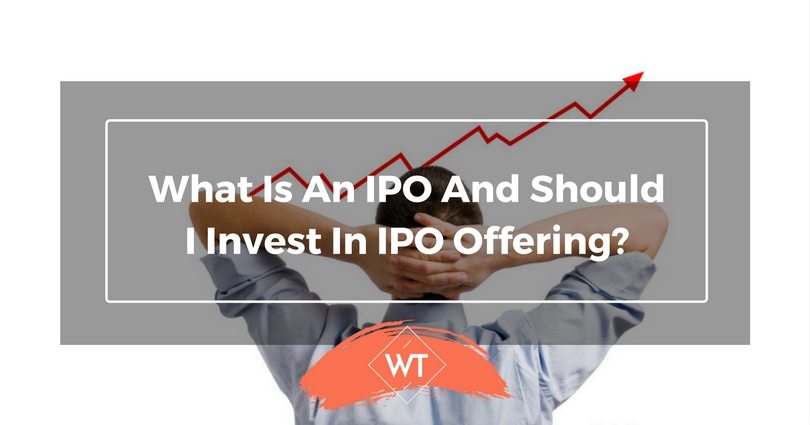What is an IPO and Should I invest in IPO Offering?

IPO or Initial Public offering is first sale of shares of a private company to public. In simple terms it is the process by which a new company enters public markets or stock markets to raise equity. For Example LinkedIn a professional social networking company launched its IPO recently, and on the date of listing its price more than doubled.
Similarly Coal India saw an overwhelming response to its IPO and was issues at Rs.245/share. However, on the day of listing it opened at Rs.291 and even went up to Rs.320. Today it is well above the Rs.400 mark.
IPO Success Stories – Take these with a pinch of salt
There are many IPO success stories when we look in to the past. We will also hear stories from our friends, relatives, colleagues and other folks. But remember that IPO investing can be highly risk and could see major price erosion if the market situation or sentiments are not favorable.
Moreover, there could be issues related to the company or industry that can impact the IPOs. Many investors try to second guess and invest in IPOs based on news, rumors and general impressions about a company. In such circumstances even the most popular and hot IPOs can fail miserably if the fundamentals of the company or industry are not perceived to be strong.
Example: DLF, India’s leading real estate development company came up with a public issue July 2007 with an issue price of Rs.525. Now it is trading at almost half of that price. Obviously the economic slowdown in 2008 and 2009 had eroded the prices of most real estate firms.
Although it is difficult to predict the performance of an IPO a closer look at the past performances would give some idea about the market sentiments as well as industries which are fundamentally strong.
Myth vs. Reality
IPOs are not the best way to start investing because its like swimming in untested waters or venturing in to unknown territories. In addition to the risks covered above people have misconceptions about IPO which I want to clarify here. This would help you to understand the risks and issues related to IPO before investing your hard earned money in it.
The 3 Ms (Myths, Misconceptions and Mistakes) that you should avoid are discussed below.
Myth #1
Myth: New issue is generally cheaper or available at attractive price than listed companies.
Reality: This is simply a generalization without rationale. There are under priced, over priced as well as fairly priced IPOs so its wrong to assume that price is attractive. One has to compare with peers to check its performance. For example you can look at the company’s PE ratio and compare it with its listed competitors to get an objective view.
Myth #2
Misconception: Attitude to invest in something brand new.
Reality: Most people have this attitude. Its just an influence from other life experiences such as shopping, buying a mobile phone, gadgets, etc. For some people it’s a sense of pride to have invested in a new IPO. This is absolutely wrong. The craze is comparable to buying latest version of a laptop or smart phone with the most advanced and updated features.
Does this sound foolish? Yes but this happens knowingly or unknowingly. Investing is about making your money work for you, which means you need to deploy it in the right avenues to fetch good returns. To put it in a nutshell you would be better off investing in index stocks rather than applying for an IPO because these stocks have been in the market for years or decades and have solid performance and have thrived and succeeded in the market across different economic cycles.
Myth #3
Myth: I invest for listing gains so the risk is minimal.
Reality: This is a flawed assumption, because prices can dramatically change on listing. Some issues have lost close to 30% or more after listing. Remember that if you investing for listing gains then you need to be prepared for losses as well. Playing for listing gains is as good as ‘gambling’. It is like punters betting on Delhi Daredevils or Kolkata Knight Riders in the IPL season.
Myth #4
Mistake: Borrowing to invest in IPO. Many financial institutions and brokerage firms provide loans or margin money to invest in IPOs. This is a good strategy to invest because if you don’t have enough money you cannot bid for more stock in an issue. So a loan enables you to access more funds and apply for more shares and a higher probability of getting allotment or sometimes a higher quantity of shares if all your shares get allotted.
Reality: Yes if markets are bullish and stock gets listed at a higher price and you make gains its like a smart strategy to make money. What if the price of the stock plummets by 20% on listing?
For instance if you had bought 100 shares of ABC at Rs.100, and it plummets to Rs.80. Assuming you had borrowed funds Rs.10,000 @ 15% p.a. interest you not only lost Rs.2000 (-20 X 100 shares), but also need so shell out the interest for the borrowed the money. It’s a double whammy. This is how leverage can magnify your losses. The lesson is simple. Don’t use borrowed money (leverage) to invest in stocks. Don’t ever borrow and invest even if it were the best stock in the world to invest in.
Myth #5
Myth: I am a long term investor and believe that in the long run I will be able to get decent returns despite short term volatility
Reality: This is not a generic rule that you can apply to all IPOs. You can invest with a long term perspective in good listed companies which have a proven track record. But if you still wish to invest in the IPO you must have sufficient data and information to justify or prove that the funds you invest will be used to create significant value in the long term for investors.
But also remember that you may see some disappointment when the price after listing is much lower than the issue price at which you purchased. For instance you may have purchased DLF at Rs.500 and on listing it goes down to Rs.300 odd levels.
Our discussion on myths and reality can go on and on but lets cut the fluff and come to the main point. Should you invest in IPOs. My answer is ‘No’ unless you have some knowledge about the company, its prospects, industry, quality of management, etc.
It’s not easy to become a master stock picker like Warren Buffet or Rakesh Jhunjhunwala, but one must atleast be aware of the company, the stock and the risks associated with it.
What to look for if you invest in an IPO?
Companies file their draft red herring prospectus (DRHP) with SEBI. The prospectus is one of the key documents that investors must look in to in addition to other information and financial statements filed by the company. The following factors have to be looked in to before investing in the IPO
Promoter Holding:
Although a higher promoter holding is not a conclusive to make decision it is still important. Many family businesses and promoter run companies have a high promoter shareholding – say more than 75%. In this case you have to see if any financial institutions, banks, funds, etc have a stake.
Presence of institutional investor will be a positive signal. If there is little or no institutional participation then probably it is better to wait and watch before you put in your bids.
IPO Grading:
Grading is an indicator of the fundamentals of the company, but it cannot be used as a sole parameter. For example Vasvani Industries had an ICRA grading 2/5 (indicating below-average fundamentals).
Here it is advisable to be cautious or avoid IPOs with lower grading. However, you should not be happy to invest simply because a company received a higher grading. Grading is a little nascent in India and has to be viewed as one of the factors in your investment decision making.
Some companies withdraw from IPO if the market conditions are not conducive. For instance Galaxy Surfactants recently withdrew its IPO despite the fact that it had been graded 4/5 by CRISIL indicating above-average fundamentals.
Withdrawal of an may IPO sound disappointing, but remember that even good companies may decide to cancel the IPO if they find it difficult to raise funds due to poor market sentiments.
Quality of Management:
This is easier said than done, because the million dollar question is how do I evaluate the quality of management? A few pointers could include their past background, work experience, qualifications, their term within the company, performance in the company, projects handled, etc. Most of the information is available in the prospectus and other documents filed with the regulator.
Promoter Backing:
A strong promoter backing can be a positive if the promoter has a strong track record or reputation. Promoters of large business houses in India like Tatas can bring in lot of credibility.
Listing of such companies will have a premium in the market. In the case of public sector undertakings (PSUs) the ownership of government will have a high safety factor.
So government owned firms which go public are perceived as safe investments, however their performance is also subject to market trends. Many PSU IPOs have created wealth for investors in the long-run.
Objective of Raising Funds:
This should in fact be the first question or point to be addressed. The objectives of the issue will give you a sense of where and how the money is going to be deployed. You also need to look at the business, its past performance, future growth prospectus, potential rate of return, profitability, etc.
One must also look at the inherent risks that the business has. For example oil exploration companies will have a huge gestation period spanning a few years until they discover, extract and sell their produce. The legendary Warren Buffet used to advice people not to invest in businesses they cannot understand. This should be applied to IPOs as well.
Comparison with Peers:
There is a lot of news and buzz during an IPO. But in the midst of all the hype where media bombards you with advertisements and recommendations, look at the peer companies or competitors.
Similarly select television news channels may have analyst who talk about the IPO and compare it with companies in the similar industry who can give you a comparative analysis. Pick some data of a couple of competitors and see where the IPO pricing in relation to its peers.
This will tell you if the IPO is under priced or overpriced and also indicate if there are alternate opportunities to invest in.
Review and Follow up:
Once you invest in an public issues, keep a close watch on it so that you can take corrective action if it turns out to be a nasty surprise later on. However, this does not mean you need to sell out the moment the IPO underperforms.
There are several IPOs which have underperformed in the short run but managed to generate consistent returns over the long run.
The motivation of selling would apply if losses get beyond your tolerance limit or if the company is fundamentally doing something basically wrong (like diverting funds from its core business to investments or non-core activities).
Conclusion
In any case investing in a listed company with a good history or track record is always better than taking changes in an IPO. Past performance is not an indicator of future prospects, but it can definitely provide you with facts and data about the capabilities of the company. For those who like to take a middle path an FPO (follow on public offer) is a good choice.
FPO is an issue by a listed company to raise additional funds for capacity expansion, investment, etc. The advantage here is the company’s proven track record and history to back it up.
Investing in IPOs have to be restricted to a very minimum level because it involves a lot of research and study in addition to high uncertainties and lack of market history of the company. IPOs have to be chosen very selectively or avoided altogether in order to ensure that your core portfolio or investments is not affected due to one bad performance.
Disclaimer: All the above opinions are derived from news and facts, and should not be taken as a buy or sell recommendation. The information is purely for knowledge sharing and awareness.









Leave a Reply